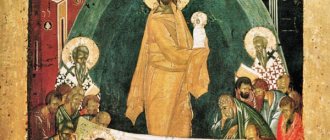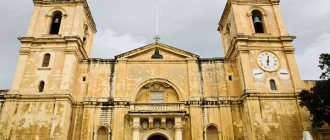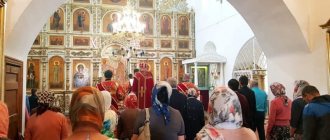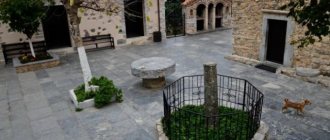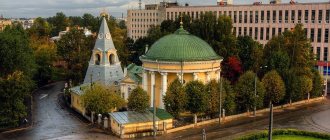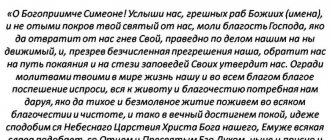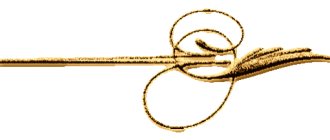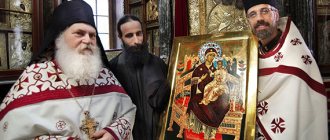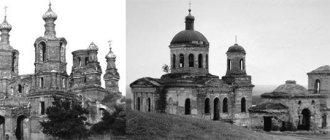The icon depicts the Virgin Mary with the Child of God in her arms, who holds a cross in his right hand. On the table next to the image there is a bowl and a spoon with a cross. To the side of the image there is a bowl and a spoon next to it. It can be assumed that the artist placed these images near the Eternal Child, intending to point to Him as the future establisher of the sacrament of Holy Communion.
Story
The icon is of Italian origin, painted in the 15th-16th centuries. She was brought to Russia by a lady-in-waiting of Empress Elizabeth of Italian descent. Later it becomes a family heirloom of Count Kapnist's family.
The icon was named after the village of Kozelshchyna, where the first miracle of healing took place. On February 21, 1881, through the prayer before her, Countess Maria, daughter of Count Vladimir Kapnist, who had been suffering from a leg disease since 1880.
Before going to the doctors in Moscow, Maria turned to the Mother of God in prayer and, according to family tradition, cleaned her robe. According to legend, immediately after the prayer, Maria felt relief and came to Moscow to see the doctors completely healthy.
Icon dimensions:
- height - 45 cm;
- width - 36 cm.
An inexhaustible source of miraculous healings: about the Kozelshchansk Icon of the Mother of God
On March 5 (February 21, O.S.), the Orthodox Church honors the miraculous image of the Kozelshchanskaya Icon of the Mother of God, one of the copies of which is called “Inexhaustible Grace.”
The history of the glorification of this icon is closely connected with the eminent noble family of the Kapnists, who owned an estate in the village of Kozelshchina, Poltava province at the time of the first miraculous healing received from this image. The icon was a family heirloom of the wife of Count Vladimir Ivanovich Kapnist - Sofia Mikhailovna, née Ostrogradskaya - who passed to her along with the estate from the former owner Pavel Kozelsky.
Vladimir Ivanovich Kapnist is the grandson of the famous playwright, poet, satirist and social and political figure V.V. Kapnist (1758–1823) in Ukraine and Russia. He, like his father and grandfather, worked a lot for the good of the Fatherland and Orthodoxy. In particular, thanks to his efforts and labors, as well as the efforts of his wife, the Nativity of the Mother of God convent was founded in the Kozel region in 1885, to which the ancestral shrine of the family was transferred - an icon that immediately gained enormous popularity throughout Ukraine and Russia due to many events that took place healing from her. In addition, cultural, educational and charitable centers were created at the monastery, which carried out active work until the very moment of their closure and ruin by the godless authorities.
The Kozelshchansk Icon of the Mother of God is an image of an Italian letter by an unknown artist, the time of painting of which has not yet been established. The Mother of God is depicted half-length in a tunic strewn with stars, sitting at a table with the Infant of God on her lap, who holds a cross in his hand. On the table there is a vessel and a spoon lying, as if as a sign that the Most Pure Virgin is the Chalice, drawing joy and representing an inexhaustible source of grace-filled miracles.
According to the “Legend” about this miraculous image, the icon initially came to Ukraine thanks to the maid of honor of Empress Elizabeth, who married the Zaporozhye military clerk Siromakha. It should be noted that the Kozelshchanskaya icon is one of the images whose miraculous power was revealed relatively recently. In any case, before 1881 there are no reliable facts about this. But after this date, documents, letters, and records have been preserved that testify to its healing power. What happened in 1881?
The Kapnist couple had a minor daughter, Maria, a very playful and active girl, who suddenly fell ill with an incomprehensible illness that led to curvature and dislocation of the joints, and then to immobilization. Treatment by different doctors and prescribed procedures did not yield anything. The girl's father turned to the famous French professor Charcot, and he agreed to examine his daughter in Moscow. On the eve of departure, the mother advised her daughter to pray in front of the icon and clean her robe for a successful outcome of the trip. Fervent and sincere prayer led to the complete recovery of the girl, who was nevertheless taken to Moscow, but for an examination on the occasion of her healing. Notes from Maria's medical history, signed by Professors Charcot and Sklifosovsky, confirm this amazing fact. Maria herself told about all this in 1920, while in Odessa, to the priest Fr. Alexander Vvedensky, whose apartment she lived with. Father Alexander many years later shared the details of this story with Mother Antonia (Zheltkova) in his letter.
Unfortunately, the fate of Maria Kapnist herself was very unfortunate. The girl, in a fit of gratitude for the healing, made a promise to God not to marry, but did not keep it. Her first husband turned out to be a bitter drunkard and died early, the second, a famous geologist, professor at the Kyiv Imperial University P. Ya. Armashevsky, was shot by security officers in 1919. According to the testimony of Father Alexander, Maria died as a true Christian in complete reconciliation with everyone with prayer on her lips and was buried in the Odessa cemetery in 1921 under the name Armashevskaya.
After Maria's incredible recovery in 1881, news of this miracle quickly spread throughout Russia. Already in Moscow, when the family arrived there for a consultation with Professor Charcot, Orthodox Christians gathered at the Kapnist house, wanting to honor the image of the Mother of God, thanks to which the girl was healed. In Moscow, over time, a list was made from the icon, called “Inexhaustible Grace.” Believers also began to receive help from the Moscow list of the Kozelshchansky image of the Blessed Virgin Mary. When the family returned to Kozelshchyna, pilgrims rushed there. At first, prayer services were served in front of the icon right in the open air, then a chapel was erected, and later a church and a cathedral at the monastery. The premises and interior decoration of the cathedral were considered one of the best in Ukraine and Russia at that time. The amazing iconostasis made of white marble especially attracted attention.
During a turbulent time for Russia on the eve of the Russo-Japanese War, the monastery was visited by the future passion-bearer Emperor Nicholas II, who wished to venerate the miraculous image of the Mother of God. The fact that the Kozelshchanskaya Icon of the Mother of God helped many people was told by letters that often began to arrive to Count V.I. Kapnist. So, one of the first to arrive was a letter from the village of Solonitsi, Kremenchutsk district, from the tradesman M.K. Mirgorodsky. A resident of this village, G.I. Pilipenko, on the advice of a tradesman, visited the Kozelshchansky miraculous icon together with his son, who was suffering from severe epilepsy. After a prayer service and touching the icon, the boy received healing. During the reign of the godless authorities, the Kozelshchansky monastery was destroyed. The nuns were dispersed and some were arrested. On the eve of the closure of the monastery in 1929, bloody tears appeared on the face of the image of the Mother of God located at the gates of the monastery. The Soviet government, in order not to attract attention to the miracle, forced Abbess Olympias and several other sisters to sign a false document confirming that paint had appeared on the icon. The sisters refused and were sent to Poltava prison. In 1938, Mother Superior Olimpiada (Verbitskaya) was brutally tortured in prison - a cross was cut out on her chest. The place of her burial remains unknown.
From the beginning of the Great Patriotic War until its second closure in 1949, the monastery functioned. During the period of persecution and closure, the miraculous image was kept in different places, and since 1961 - in the Kyiv apartment of the former nuns of the monastery. In 1993, after the restoration of the monastery, the miraculous icon returned to the Kozel region. The first miracles began immediately along the way of the icon to the monastery. In the city of Kremenchug, where she was exhibited for worship, a boy with a tumor on his leg, who was being prepared for surgery, received healing. On February 23, 1993, when the sisters of the monastery went out to meet the icon, a new miracle occurred: the healing of Archimandrite Anthony from the Gomel diocese, who was sick with the flu, but despite his illness, still came to the celebration. As soon as he took the miraculous image in his hands, he immediately began to sing, although before that he could not even speak. The people present testified that the archimandrite sang louder and better than anyone else. In the spring of the same year, a man with eczema who came with pilgrims from Kirovograd received healing from his illness after using oil from the lamp of the miraculous icon. You can learn about many miracles that occur through appeal and prayer to this miraculous image from the monastery book, which records unusual cases.
In 2007, another amazing event happened. In the main church of the recently established Melitopol Monastery of St. Sava the Consecrated, the faces of the Most Pure Mother of God and the Infant God were displayed on the glass of the icon case of the Kozelshchanskaya Mother of God. The icon case was old, and the carpenter had to replace it with a new one. While dismantling the icon case, he discovered a display. After this, both the icon and the glass in separate icon cases were placed in the temple for the worship of believers. The displays on the glass are quite clear.
The Kozelshchanskaya icon is called the “pearl” of the Poltava region. She is one of the most revered images of the Mother of God among Orthodox believers, continuing to provide assistance, strengthen faith, and bestow strength and healing. This icon can be described in the words of a wonderful poem, expressing the essence of the hopes and expectations of every believer who turns to the Lady of the world with his sincere prayers:
Who among the sinners did not fall to Her icon at the hour of prayer, Like a recruit before battle, Who did not cry out for salvation?
Both in body and in spirit, the afflicted, beaten down by life, - She turned to them with sensitive ears, and hurried a cry to their souls.
And having satisfied the sorrows of the laity in full with the Holy Measure, So that they would not become poor in spirit in the future, She asked the Lord.
What does it help with?
From time immemorial, a custom has been established for the person praying to clean the robe on the holy icon, wiping it carefully with cotton wool or a clean towel. How many times has a prayer been answered during such an appeal? They pray to the Kozelshchansk Icon of the Mother of God:
- for mental disorders;
- for bodily illnesses;
- for the arrangement of family well-being;
- to get married.
Description of the miraculous image
The miraculous icon of the Mother of God of Kozelshchanskaya, telling believers about the meaning of the Eucharist, was painted on a wooden tablet measuring only 30*40 cm.
According to the type of iconographic image of the Mother of God, this is Hodegetria. According to legend, the first icon of this type was painted by the Evangelist Luke.
Kozelshchansk Icon of the Mother of God
Reclining in the arms of the Mother, Christ looks directly at the person praying, holding a cross in his right hand. Next to Christ and the Mother of God on a small table are the Chalice and the Liar, speaking of the unsurpassed role of the Sacrament of Communion in the spiritual life of the Orthodox.
The Sacrament of Communion or the Eucharist was established for all Orthodox Christians by Christ himself during the Last Supper, when He broke bread and said to the disciples: “Take, eat, this is My Body, broken for you,” blessed the wine with the words “this cup is a new covenant in My Blood."
About other Sacraments of the Church:
- Sacrament of Confession
- Sacrament of Confirmation
- Sacrament of Baptism
Important! Only one who regularly approaches the Chalice with a pure heart and thereby unites with Christ can be called a member of the Church.
What is this miraculous face of the Mother of God asking for?
This icon is considered healing. She helps:
- for diseases (primarily diseases of the eyes, back, legs and arms);
- for any other diseases;
- for spiritual illnesses (including weak faith, confusion, depression);
- if a person realizes that he or someone close to him lacks patience and wisdom;
- in case of scandals in a couple or family, when the relationship is on the verge of breaking;
- girls ask for a worthy young man to come into their lives, and if one already exists, then for marriage and a happy life after the wedding and painting;
- and just about gaining strength to fight the overwhelming problems.
You can pray in different words. But there is also a separate prayer addressed specifically to Our Lady of Kozelshchansk:
In addition, a troparion (a chant praising this icon) was created. Here are his words:
Miracles of the Holy Face
The miracles of healing of Muscovites who prayed to the Kozelshchanskaya icon immediately after the first healing it revealed do not exhaust the gracious help that the Mother of God herself gives to believers through her image.
- In 1941, at the height of the bombing of Moscow, not a single shell fell on the hospital of St. Alexis, Metropolitan of Moscow.
- In September, one of the hospital workers walked around its territory with the Kozelshchanskaya icon of the Mother of God. One of the churches on the hospital grounds was also dedicated to this image of the Mother of God.
- One of the parishioners of this church told a story about the mother of a soldier who fought on the front of the Great Patriotic War. The woman prayed fervently in front of the Kozelshchansk Icon of the Most Holy Theotokos for the health of her son. And the soldier not only returned from the war, but also did not receive a single injury.
- In difficult years, the Kozelshchanskaya Mother of God also saved from arrests: the prayer of his wife before this icon in the 30s saved one of the aircraft design engineers Boris Popov from repression.
Kozelshchansk Icon of the Mother of God
Revival of the monastery
In 1941, the monastery was opened, but not to its full extent. In 1949, the monastery was closed again, and only in 1990, when the mass return of churches and other religious buildings to believers began, services began at the Nativity of the Virgin Mary convent.
Throughout the hard times, the Kozelshchanskaya Icon of the Mother of God was preserved in a private apartment of people faithful to Orthodoxy. In 1993, the miraculous image solemnly returned to the walls of the monastery, where it remains today. The monastery is continuously working to recreate the original appearance of all its buildings. The parishioners of the temple and numerous pilgrims provide great assistance. Soon the monastery will regain its historical appearance.
Meaning of the icon
The meaning of the Kozelshchanskaya icon is associated with the unique composition and the symbols of Communion present on it. The Baby Jesus reclines on the lap of the Mother of God, holding a cross in his right hand. Nearby there is a table with a Chalice and a Liar - theological symbols indicating the establishment of the Sacrament of Communion.
On the one hand, the icon painter emphasized the greatness and sacrifice of Jesus Christ, as he established the Sacrament of Communion and gave his blood and flesh to people to eat.
On the other hand, these symbols also indicate that the Mother of God is an inexhaustible source of miracles and grace. One of the lists of the icon is called “Inexhaustible Grace.”
